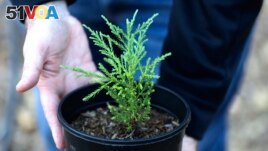04 January 2024
Some important tree species native to the northwestern states in the U.S. are no longer growing well because of climate change.
As conditions change in states such as Washington, Oregon and California, trees such as the Douglas fir, Western red cedar, giant sequoia and redwood may need to move -- with the help of humans.
Some of the trees do not do well when temperatures rise. Others suffer during times of drought. The goal is to move the trees to areas where the climate might more suitable.

FILE - City of Bellevue Forest Management Program Supervisor Rick Bailey holds a juvenile giant sequoia in his hands on Oct. 11, 2022, in Bellevue, Wash. (AP Photo/Manuel Valdes, File)
Forest scientists are generally in favor of moving the trees so they do not die out. However, not all of the scientists agree on the best way to do it.
There are three ways to move trees: assisted population migration, assisted species migration and range expansion.
Assisted population migration involves scientists moving a tree's seeds within its current growing range. Assisted species migration involves scientists moving a species far from its existing area. In this case, that would include moving redwoods and sequoias from California to Washington.
The third way, range expansion, moves trees just outside their current growing range. Each way has different results for the trees and other animals and insects that depend on the trees.
Michael Case is a forest ecologist at the Nature Conservancy in Virginia. He said "there is a huge difference" among the different migration methods.
He said the risk of failure increases "whenever you plant something in an area where it is not locally found." He said the risk is not only to the trees. There is also the risk of causing problems in the ecosystem.
Case is working on an assisted population migration program with Douglas fir and Western hemlock trees. He is testing whether the trees, originally from drier parts of the northwest, can do well in western Washington where there is a drought. His organization believes that assisted population migration has fewer risks.
The U.S. Forest Service also takes part in assisted population migration programs. Dr. David Lytle is the agency's deputy chief for research and development. He said the agency is "very very cautious" about moving plants outside of their "historic range."
Douglas Tallamy is a professor of entomology and wildlife ecology at the University of Delaware. He said one worry about species migration is that local caterpillars might not eat the leaves of trees that are new to the area. The caterpillars serve as food for birds and other animals, so they must have a good food source.
Although the concerns are documented, the city of Portland, Oregon, is working on a species migration project for 11 tree species. The project includes three oak trees: California black oak, canyon live oak and interior live oak. Tallamy said oak trees are among the most important in North America. "When you move them out of range," he said, "the things that are adapted to eating them no longer have access to them."
The city responded to questions from the Associated Press, and said it is using guidelines "from universities, state and federal sources" and more, in its project.
Another group working on species migration projects in the northwest is called PropagationNation. To propagate means to produce a new plant through the use of seeds or parts of another plant.
That organization is planting non-local trees around the Seattle, Washington area in hopes that they will start growing in places where Western red cedar, Western hemlock and big leaf maple are having trouble.
David Milarch is the leader of a group in Michigan that supports keeping old trees alive. It is called Archangel Ancient Tree Archive. Milarch said the hope is to permit redwoods and sequoias to grow in areas to the north. The hope is not to replace native trees.
He said his group hopes the trees "will still be here in 100 to 200 years and not join the list of trees that are going extinct."
The organizations that are not practicing widely accepted methods for moving species feel like the risks are worth it.
But Robert Slesak is not sure about either practice. He oversees population migration sites run by the U.S. Forest Service in California, Oregon and Washington.
He said he has concerns about assisted species migrations and assisted population migrations that lack experimental rigor. Rigor describes an activity that has been tested with high standards.
He said all of the ideas about how to move trees should follow experiments that have already produced strong results.
"Everyone knows we need to do some kind of action related to climate, but there's a real risk of making it worse."
I'm Dan Friedell.
Dan Friedell adapted this story for Learning English based on a report by the Associated Press.
_________________________________________________
Words in This Story
drought –n. a dry weather period
suitable –adj. comfortable or correct
migration –n. the movement of something to a new place
range –n. the usual area of land covered by a plant or tree (in this case)
ecologist –n. a person who studies living things and their environment
locally –adj. a small area where something is originally found
cautious –adj. careful or concerned
adapted –adj. something that has changed and now functions in a new place
respond –v. to answer
replace –v. to put something new in place of something
to go extinct –v. to die out
rigor –n. the quality of being exact, careful or strict